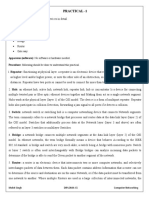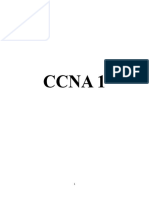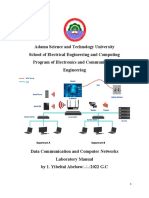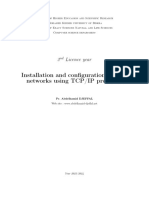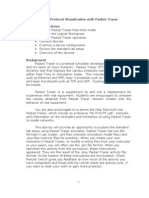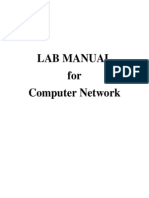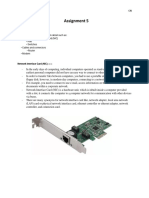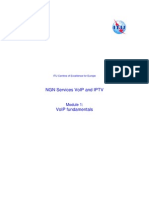Lab 2 Handout
Lab 2 Handout
Uploaded by
hassaan tanveerCopyright:
Available Formats
Lab 2 Handout
Lab 2 Handout
Uploaded by
hassaan tanveerCopyright
Available Formats
Share this document
Did you find this document useful?
Is this content inappropriate?
Copyright:
Available Formats
Lab 2 Handout
Lab 2 Handout
Uploaded by
hassaan tanveerCopyright:
Available Formats
University of Engineering & Technology (UET)
Taxila
Computer Networks LAB
Instructor: Engr. Awais Khan
EXPERIMENT # 02: Setting up a small Network
Name of Student: …………………………………..
Roll No.: ……………………………………………
Date of Experiment: ………………………………..
Report submitted on: ………………………………..
Marks obtained: ……………………………………
Remarks: ……………………………………………
Instructor’s Signature: ……………………………...
Computer Networks Lab Page 1
Setting up a small Network
1. Objective
This lab exercise is designed to demonstrate and help in learning & understanding of the
procedure of setting up a small network (that can be used in homes too).
2. Resources Required
• Straight & Cross Cat5 UTP cables – (made in last lab)
• Computers
• A Switch/Hub (if network size is to be increased)
• A Router (if communication is to be done with WAN/Internet)
3. Introduction
This lab introduces NIC (Network Interface Controller/Card), Switch/Hub & Router. Before
going to the procedure, firstly a small introduction of the devices is given.
3.1 NIC (Network Interface Card)
A network interface controller is a computer hardware component that connects a computer to a
computer network. The controller may also be referred to as a network adapter, or a LAN
adapter. Also known as a network interface card, network card or LAN card.
It is both an OSI layer 1 (physical layer) and layer 2 (data link layer) device, as it provides
physical access to a networking medium and provides a low-level addressing system through the
use of MAC addresses. It allows users to connect to each other either by using cables or
wirelessly.
Computer Networks Lab Page 2
3.1 Hub
An Ethernet hub, active hub, network hub, repeater hub or hub is a device for connecting
multiple twisted pair or fiber optic Ethernet devices together and making them act as a single
network segment. Hub works at the physical layer (layer 1) of the OSI model. The device is a
form of multiport repeater. Repeater hubs also participate in collision detection, forwarding a
jam signal to all ports if it detects a collision.
A network hub is a fairly unsophisticated broadcast device. Hubs do not manage any of the
traffic that comes through them, and any packet entering any port is regenerated and broadcast
out on all other ports.
3.3 Switch (LAN Switch)
Switches are devices capable of creating temporary connections between two or more devices
linked to the switch. It acts just like hub but has advanced features for network optimization &
better security. Switch works at the Data Link layer (layer 2) of the OSI model. The work a
switch does is called switching.
Switches that additionally process data at the network layer (layer 3 and above) are often referred
to as Layer 3 switches or multilayer switches.
The main purpose of both Switch & Hub is to extend the size of network.
3.4 Router
A router is a device in computer networking that forwards data packets to their destinations,
based on their addresses. The work a router does is called routing, which is somewhat like
switching, but a router is different from a switch. The latter is simply a device to connect
machines to form a LAN.
Routers work at the Network layer (layer 3) of the OSI model. Their main purpose is to
allow communication between different network.
Computer Networks Lab Page 3
4. Network Commands (Testing)
The widely used commands for testing network connectivity are PING, TRACERT & TELNET.
(Just remember these commands are not case sensitive so PING is same as ping or PinG)
4.1 PING
Ping is a computer network administration utility used to test the reachability of a host on an
Internet Protocol (IP) network and to measure the round-trip time for messages sent from the
originating host to a destination computer.
ping target_name/target_IP
4.2 TRACERT
Tracert determines the path taken to a destination by sending Internet Control Message Protocol
(ICMP) Echo Request messages to the destination with incrementally increasing Time to Live
(TTL) field values. The path displayed is the list of near-side router interfaces of the routers in
the path between a source host and a destination. The near-side interface is the interface of the
router that is closest to the sending host in the path.
This utilty is available as traceroute in some operating systems.
tracert target_name/target_IP
4.3 TELNET
Telnet is a network protocol used on the Internet or local area networks to provide a bidirectional
interactive text-oriented communications facility using a virtual terminal connection.
Historically, Telnet provided access to a command-line interface (usually, of an operating
system) on a remote host. Most network equipment and operating systems with a TCP/IP stack
support a Telnet service for remote configuration (including systems based on Windows NT).
Because of security issues with Telnet, its use for this purpose has waned in favor of SSH
(Secure SHell).
telnet target_name/target_IP
MS DOS command window showing use of ping
Computer Networks Lab Page 4
5. Procedure to setup Network
(For this lab only - consider the switch & router automatically configured)
1. Connect devices to each other with the correct UTP (straight/cross) cables and
power them ON.
2. Use the Control Panel/Network Connections (or Properties in Context Menu of
My Network Places) to display Network Connections Window. Then use
Properties in Context Menu of Local Area Connection to display Local Area
Connection Properties Window. Select the TCP/IP protocol from the
Configuration Tab and click on properties. Check the IP Address and Subnet
mask for both workstations on the IP Address Tab.
Computer Networks Lab Page 5
3. Set IP address of PC0 to 192.168.1.2, PC1 to 192.168.1.3 & PC2 to 192.168.3.2 .
4. Set default gateway of PC0 & PC1 to 192.168.1.1 and PC2 to 192.168.3.1 .
These are actually the addresses of the router interfaces.
5. For PC4 & PC5 set any IP address and ignore the default gateway as they are
not connected to any router.
6. Test the connectivity by using the commands mentioned in section 4.
7. If everything is ok then play the multiplayer games installed on the PC.
Computer Networks Lab Page 6
University of Engineering & Technology (UET), Taxila
Computer Networks Lab
LAB WORKSHEET (Lab # 2)
Q.1 What is the purpose of Switch in a network?
________________________________________________________________________
________________________________________________________________________
________________________________________________________________________
________________________________________________________________________
________________________________________________________________________
Q.2 Identify the differences between Switch and Hub.
________________________________________________________________________
________________________________________________________________________
________________________________________________________________________
________________________________________________________________________
________________________________________________________________________
Q.3 Which OSI layer device is the following?
Router, Hub, Switch
________________________________________________________________________
________________________________________________________________________
________________________________________________________________________
________________________________________________________________________
________________________________________________________________________
Q.4 What are the differences between tracert & ping?
________________________________________________________________________
________________________________________________________________________
________________________________________________________________________
________________________________________________________________________
________________________________________________________________________
Computer Networks Lab Page 7
You might also like
- Data Communication & Computer Networking-lab-ManualNo ratings yetData Communication & Computer Networking-lab-Manual68 pages
- Serial Port Complete: COM Ports, USB Virtual COM Ports, and Ports for Embedded SystemsFrom EverandSerial Port Complete: COM Ports, USB Virtual COM Ports, and Ports for Embedded Systems3.5/5 (9)
- LAB 3B - LAN and VLAN - Creation and ConectivityNo ratings yetLAB 3B - LAN and VLAN - Creation and Conectivity14 pages
- Pillai HOC College of Engineering and Technology, RasayaniNo ratings yetPillai HOC College of Engineering and Technology, Rasayani67 pages
- Data Communication & Computer Network-lab-ManualNo ratings yetData Communication & Computer Network-lab-Manual68 pages
- Government College of Engineering, Karad: EX708: Computer Communication Networks Lab ManualNo ratings yetGovernment College of Engineering, Karad: EX708: Computer Communication Networks Lab Manual39 pages
- Computer Networks Laboratory Manual - V4No ratings yetComputer Networks Laboratory Manual - V454 pages
- Digital Communication and Computer Networking Lab ManualNo ratings yetDigital Communication and Computer Networking Lab Manual66 pages
- Networking Finalreport Without Table of ContentNo ratings yetNetworking Finalreport Without Table of Content46 pages
- Introduction To Networks Version 70 ITNv7 Practice Final Exam AnswersNo ratings yetIntroduction To Networks Version 70 ITNv7 Practice Final Exam Answers27 pages
- CCNA 1 Chapter 2 Exam Answer v5 & v5.02 2015 (100%) : March 21, 2015 byNo ratings yetCCNA 1 Chapter 2 Exam Answer v5 & v5.02 2015 (100%) : March 21, 2015 by14 pages
- Files 3 2021 August NotesHubDocument 1628169111No ratings yetFiles 3 2021 August NotesHubDocument 162816911119 pages
- PT 8.2.5.4 Stadium Redundancy Test Plan StudentNo ratings yetPT 8.2.5.4 Stadium Redundancy Test Plan Student14 pages
- Computer Networking: An introductory guide for complete beginners: Computer Networking, #1From EverandComputer Networking: An introductory guide for complete beginners: Computer Networking, #14.5/5 (2)
- Cisco Certified Network Associate (CCNA) and Cisco Certified Network Professional (CCNP): Mastering Network Automation and Programmability Study GuideFrom EverandCisco Certified Network Associate (CCNA) and Cisco Certified Network Professional (CCNP): Mastering Network Automation and Programmability Study GuideNo ratings yet
- CISCO PACKET TRACER LABS: Best practice of configuring or troubleshooting NetworkFrom EverandCISCO PACKET TRACER LABS: Best practice of configuring or troubleshooting NetworkNo ratings yet
- CompTIA Network+ (N10-009) Study Guide: Comprehensive Exam Preparation and Key Concepts for Network ProfessionalsFrom EverandCompTIA Network+ (N10-009) Study Guide: Comprehensive Exam Preparation and Key Concepts for Network ProfessionalsNo ratings yet
- Cisco Packet Tracer Implementation: Building and Configuring Networks: 1, #1From EverandCisco Packet Tracer Implementation: Building and Configuring Networks: 1, #1No ratings yet
- 159 Technical Interview Questions For Ericsson100% (2)159 Technical Interview Questions For Ericsson2 pages
- Simple Vlan Connection Using Packet TracerNo ratings yetSimple Vlan Connection Using Packet Tracer7 pages
- Manual Comunicaciones de Protocolo DNP3.0 y Modbus PDFNo ratings yetManual Comunicaciones de Protocolo DNP3.0 y Modbus PDF78 pages
- Quectel GSM SMTP AT Commands Manual V1.2No ratings yetQuectel GSM SMTP AT Commands Manual V1.221 pages
- RG301854 - FR2LTE and RG302343 - EFR2LTE - 06122016No ratings yetRG301854 - FR2LTE and RG302343 - EFR2LTE - 0612201652 pages
- Assignment 5: Aim: Study of Network Devices in Detail Such AsNo ratings yetAssignment 5: Aim: Study of Network Devices in Detail Such As8 pages
- Switch Security Issues: An IntroductionNo ratings yetSwitch Security Issues: An Introduction37 pages
- Chapter 4a - Network Layer - The Data PlaneNo ratings yetChapter 4a - Network Layer - The Data Plane111 pages
- Nokia 7705 Service Aggregation Router: Easy Legacy TDM Migration100% (1)Nokia 7705 Service Aggregation Router: Easy Legacy TDM Migration20 pages
- Webinar Presentation Cybersecurity4ProtectionEngineersNo ratings yetWebinar Presentation Cybersecurity4ProtectionEngineers81 pages
- Huawei SmartAX MA5600T Series OLT Brochure PDFNo ratings yetHuawei SmartAX MA5600T Series OLT Brochure PDF4 pages
- Fundamentos de Redes Inalámbricas: Paulo Colomés - 2010No ratings yetFundamentos de Redes Inalámbricas: Paulo Colomés - 201055 pages
- Cisco C380 and Cisco C680 Email Security Appliance: Uick Tart UideNo ratings yetCisco C380 and Cisco C680 Email Security Appliance: Uick Tart Uide24 pages
- Data Communication & Computer Networking-lab-ManualData Communication & Computer Networking-lab-Manual
- Serial Port Complete: COM Ports, USB Virtual COM Ports, and Ports for Embedded SystemsFrom EverandSerial Port Complete: COM Ports, USB Virtual COM Ports, and Ports for Embedded Systems
- Pillai HOC College of Engineering and Technology, RasayaniPillai HOC College of Engineering and Technology, Rasayani
- Government College of Engineering, Karad: EX708: Computer Communication Networks Lab ManualGovernment College of Engineering, Karad: EX708: Computer Communication Networks Lab Manual
- Digital Communication and Computer Networking Lab ManualDigital Communication and Computer Networking Lab Manual
- Introduction To Networks Version 70 ITNv7 Practice Final Exam AnswersIntroduction To Networks Version 70 ITNv7 Practice Final Exam Answers
- CCNA 1 Chapter 2 Exam Answer v5 & v5.02 2015 (100%) : March 21, 2015 byCCNA 1 Chapter 2 Exam Answer v5 & v5.02 2015 (100%) : March 21, 2015 by
- Computer Networking: An introductory guide for complete beginners: Computer Networking, #1From EverandComputer Networking: An introductory guide for complete beginners: Computer Networking, #1
- Cisco Certified Network Associate (CCNA) and Cisco Certified Network Professional (CCNP): Mastering Network Automation and Programmability Study GuideFrom EverandCisco Certified Network Associate (CCNA) and Cisco Certified Network Professional (CCNP): Mastering Network Automation and Programmability Study Guide
- CISCO PACKET TRACER LABS: Best practice of configuring or troubleshooting NetworkFrom EverandCISCO PACKET TRACER LABS: Best practice of configuring or troubleshooting Network
- CompTIA Network+ (N10-009) Study Guide: Comprehensive Exam Preparation and Key Concepts for Network ProfessionalsFrom EverandCompTIA Network+ (N10-009) Study Guide: Comprehensive Exam Preparation and Key Concepts for Network Professionals
- Cisco Packet Tracer Implementation: Building and Configuring Networks: 1, #1From EverandCisco Packet Tracer Implementation: Building and Configuring Networks: 1, #1
- Manual Comunicaciones de Protocolo DNP3.0 y Modbus PDFManual Comunicaciones de Protocolo DNP3.0 y Modbus PDF
- RG301854 - FR2LTE and RG302343 - EFR2LTE - 06122016RG301854 - FR2LTE and RG302343 - EFR2LTE - 06122016
- Assignment 5: Aim: Study of Network Devices in Detail Such AsAssignment 5: Aim: Study of Network Devices in Detail Such As
- Nokia 7705 Service Aggregation Router: Easy Legacy TDM MigrationNokia 7705 Service Aggregation Router: Easy Legacy TDM Migration
- Webinar Presentation Cybersecurity4ProtectionEngineersWebinar Presentation Cybersecurity4ProtectionEngineers
- Fundamentos de Redes Inalámbricas: Paulo Colomés - 2010Fundamentos de Redes Inalámbricas: Paulo Colomés - 2010
- Cisco C380 and Cisco C680 Email Security Appliance: Uick Tart UideCisco C380 and Cisco C680 Email Security Appliance: Uick Tart Uide













